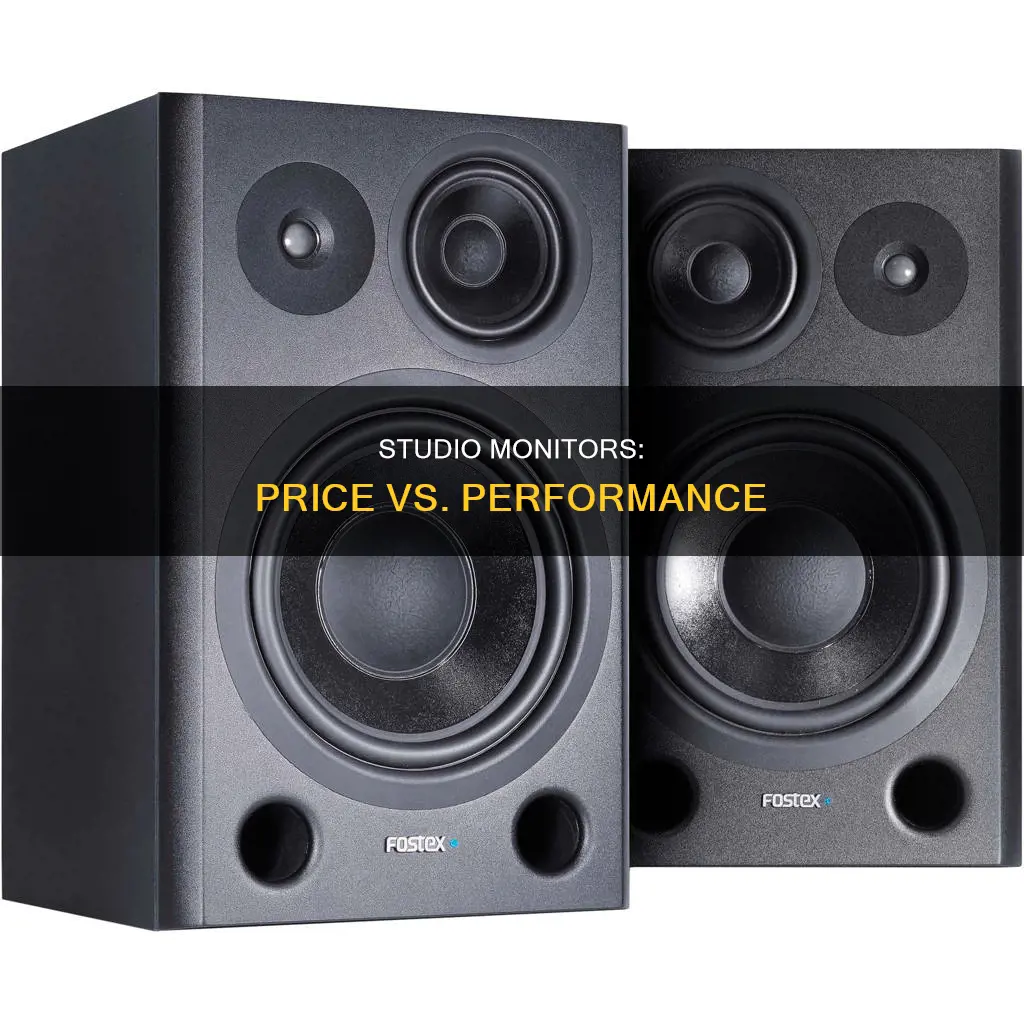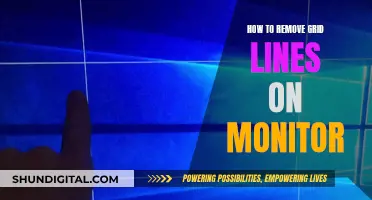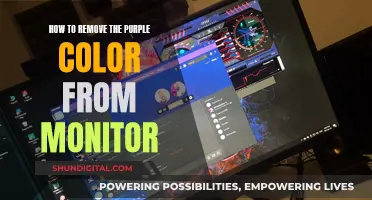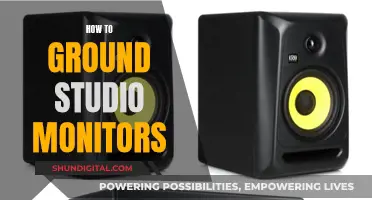
Studio monitors are an essential part of any recording studio, but are expensive studio monitors worth the investment? The short answer is yes – more expensive monitors tend to offer a wider frequency range, better accuracy, and improved stereo imaging. However, it's important to consider room acoustics and treatment as well, as even the most expensive monitors can sound lacklustre in an untreated room. Additionally, cheaper monitors can still produce good results, especially for beginners or inexperienced producers. Ultimately, while expensive monitors can provide a technical advantage, they don't guarantee better artistry.
What You'll Learn

Expensive monitors are more honest
The most important aspect of studio monitors is their ability to deliver an honest representation of your music. While cheap monitors may enhance the bass by colouring the sound, expensive monitors provide a flat frequency response, ensuring that what you hear is an accurate reflection of your mix. This is achieved through years of meticulous design and engineering, resulting in a wider range of frequencies, improved transient response, and reduced phasing issues.
The Science Behind Expensive Monitors
The science behind studio monitors is what justifies their high price tag. Manufacturers invest significant time and resources into creating monitors with an honest frequency response. This means that the sound you hear across the bass, midrange, and treble frequencies remains consistent and true to your mix. By investing in expensive monitors, you gain access to advanced technologies and materials that deliver a more accurate listening experience.
The Impact of Expensive Monitors on Your Mix
Expensive monitors provide a neutral and brutally accurate listening experience. They do not colour the sound or artificially enhance certain frequencies. This is crucial because it allows you to identify and address any issues in your mix. For example, if your bass is flabby, expensive monitors will tell you so, enabling you to make the necessary adjustments. Cheap monitors, on the other hand, may make your mix sound good on similar cheap speakers, but it will fall flat on other systems.
The Value of Expensive Monitors in the Recording Studio
In the recording studio, studio monitors are invaluable. They are the last link in the chain before your ears, and their quality directly impacts the final product. While a cheap pair of monitors may suffice for casual listening, they are not suitable for professional mixing and mastering. Expensive monitors provide a wider frequency range, improved stereo imaging, and better transient reproduction. This results in mixes that translate well across different speaker systems.
The Limitations of Cheap Monitors
Cheap monitors have their limitations. They often suffer from cabinet and cone resonances, distortion at higher volumes, and inadequate power handling. Additionally, they may have a limited frequency response, particularly in the bass range, and lack the headroom available in more expensive models. While they may be sufficient for casual listeners, they fall short for professionals seeking an honest representation of their music.
Connecting Your Wii U to an HDMI Monitor
You may want to see also

They have a wider range of frequencies
Studio monitors are incredibly valuable because they are what you test your mix on. You want speakers that are going to give you an accurate sound, with everything you designed and mixed in readily there and accessible to the ear.
The wider the range of frequencies that speakers can handle, the better. Great speakers will go down to the depths of human hearing (20Hz) and up to frequency levels that far exceed human hearing. The larger the frequency range, the more the monitors generally cost.
The lower the frequency, the larger the bass driver tends to be, so the bigger the speaker. Some speakers get away from being massive by being connected to an additional large subwoofer box that can be placed out of the way. This extends the bass further down and can be placed centrally in the system.
The other extended driver feature is simply having three drivers per speaker, rather than the two that you will find on cheaper systems. The third driver is usually a mid-range driver that delivers mid-range frequencies.
Three-way speakers tend to deliver the whole picture. The third driver also means that the woofer and tweeter don't overlap in their frequency response, which means less phasing between the two (unwanted peaks and dips in the speaker's total response).
Minimizing QBO Pages: Tips for Reducing Size on Your Monitor
You may want to see also

They have a top-notch design
Studio monitors are the single most important investment for your recording studio. While it is not necessary to spend $100,000 on a pair of studio monitors, it is worth investing in a good pair. One of the reasons why studio monitors can be so expensive is because of their design.
Studio monitors have come a long way from simply being a set of drivers mounted on a wooden box. The overall design of the cabinet and the placement of the drivers are important factors to consider when purchasing studio monitors. Manufacturers have designed speakers to deliver a wider sweet spot for larger rooms, so more people can monitor or adjust their listening position.
One such innovation is the dual-centric or coaxial design, where one driver is placed over the woofer, so it effectively sits within it. This widens the position in which you can listen accurately to your mixes, as you get less off-axis colouration. Baffle designs can also help here, with certain frequencies being dispersed and directed so that phasing is reduced.
Another aspect of top-notch design is the use of three drivers per speaker, rather than the usual two. The third driver is typically a mid-range driver that delivers mid-range frequencies. This evens out any dip in the middle part of the frequency range and joins the dots between the woofer and tweeter, resulting in less phasing between the two.
In addition to the number and placement of drivers, the materials used in the construction of studio monitors also contribute to their cost. Speaker cones may be made of durable and tough materials to prevent flabbiness and ensure a quick and accurate response to the voltage of the sound being put through them. Similarly, speaker cabinets are made with stiff materials to prevent vibration or resonance at particular frequencies, which also helps with the transient response.
The design of studio monitors is a complex process that involves years of research and testing. The high cost of studio monitors is justifiable as they are one of the most important elements of a recording studio.
Adjusting Font Size on Your ASUS Monitor: A Simple Guide
You may want to see also

They have better and faster transients
Transients refer to the attack of a sound, and how quickly it reaches its peak level. A good transient response will allow you to hear the attack of a snare drum, for example, and the "breath" in a vocal.
Studio monitors with better and faster transient responses will allow you to hear these details more clearly, and make it easier to perform tasks such as de-essing.
The Adam A5 and A7 monitors are highly regarded for their transient response, with one user describing the transients as "almost unbeatable". Drums, in particular, are said to sound "extremely snappy" on the A7s.
The PreSonus R65 and R80 studio monitors are also said to offer a fast transient response due to their Air Motion Transformer (AMT) tweeter design. This design provides a larger projection area than a traditional dome tweeter, allowing for a faster transient response, even at ultra-high frequencies.
Another option to consider is the PreSonus Eris E44 and E66 studio monitors, which feature a dual-woofer design that helps to minimise phase displacement and create an ultra-wide stereo field. This can result in a smoother frequency response and more detailed stereo soundstage, which can improve the overall transient response of the monitors.
When evaluating studio monitors for their transient response, it is important to listen to a variety of well-mixed recordings that you are familiar with, and pay attention to the attack of different instruments and the overall stereo imaging of the monitors.
Monitoring Performance: Frank's Blind Spot
You may want to see also

They can compensate for a terrible room
Even if your room is terrible, expensive studio monitors can still be worth it.
Sound from the speakers will bounce off the walls and come back to you, the listener, at different times. This is called room correction or speaker calibration.
Some speakers come with built-in calibration systems, whereby they listen to your room by sending out a frequency sweep and then monitoring the reflections that come back. They then adjust their EQ response characteristics to still deliver an accurate representation of your music, with your room now taken into account.
For example, the IK Multimedia iLoud MTM speakers are some of the cheapest monitors with room correction technology. Genelec's The Ones monitors also come with built-in calibration systems.
Additionally, near-field monitors are designed to be listened to up close, so reflections from the room are less prevalent.
Finding Mates: Water Monitors' Unique Strategies and Behaviors
You may want to see also
Frequently asked questions
Expensive studio monitors are worth it if you can afford them. They will give you an honest representation of your mix, with a flat frequency response, a wide range of frequencies, top-notch design, and better and faster transients. However, it's important to note that acoustic treatment of your room is also crucial and can be more important than the quality of your monitors.
Expensive studio monitors will give you an honest representation of your mix. They will have a flat frequency response, meaning that they won't colour the sound by enhancing or reducing certain frequencies. They will also have a wider range of frequencies, covering the entire human hearing range and beyond. Additionally, they will have a wider sweet spot, meaning you can move around more freely while mixing without losing accuracy. Finally, they will have better and faster transients, with less distortion and flabbiness.
Some good options for expensive studio monitors include the Neumann KH310A, the Focal Shape 65, the Genelec 8010A, and the PreSonus Eris E8XT. These monitors are known for their accuracy, flat frequency response, wide frequency range, and robust design.







